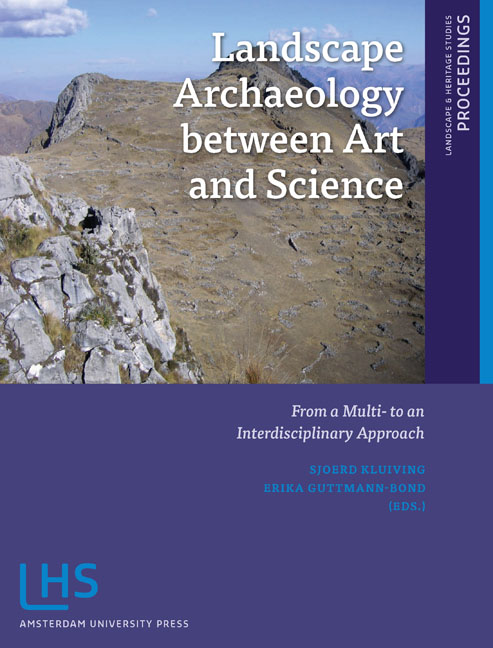Book contents
- Frontmatter
- Contents
- Preface
- Introduction: LAC2010: First International Landscape Archaeology Conference
- THEME 1 HOW DID LANDSCAPE CHANGE?
- THEME II IMPROVING TEMPORAL, CHRONOLOGICAL AND TRANSFORMATIONAL FRAMEWORKS
- THEME III LINKING LANDSCAPES OF LOWLANDS TO MOUNTAINOUS AREAS
- THEME IV APPLYING CONCEPTS OF SCALE
- THEME V NEW DIRECTIONS IN DIGITAL PROSPECTION AND MODELLING TECHNIQUES
- THEME VI HOW WILL LANDSCAPE ARCHAEOLOGY DEVELOP IN THE FUTURE?
- Miscellaneous Endmatter
6.4 - ‘Landscape’, ‘Environment’ and a Vision of Interdisciplinarity
Published online by Cambridge University Press: 21 January 2021
- Frontmatter
- Contents
- Preface
- Introduction: LAC2010: First International Landscape Archaeology Conference
- THEME 1 HOW DID LANDSCAPE CHANGE?
- THEME II IMPROVING TEMPORAL, CHRONOLOGICAL AND TRANSFORMATIONAL FRAMEWORKS
- THEME III LINKING LANDSCAPES OF LOWLANDS TO MOUNTAINOUS AREAS
- THEME IV APPLYING CONCEPTS OF SCALE
- THEME V NEW DIRECTIONS IN DIGITAL PROSPECTION AND MODELLING TECHNIQUES
- THEME VI HOW WILL LANDSCAPE ARCHAEOLOGY DEVELOP IN THE FUTURE?
- Miscellaneous Endmatter
Summary
KEYWORDS
environment, landscape, interdisciplinarity, history of archaeology, humanities, science
ABSTRACT
In this paper, presented at the end of the Amsterdam-LAC2010 conference, I felt obliged to react to the contributions delivered so far. Thus, I am starting with a few words on the term ‘environment’, which was first used at the beginning of the 20th century. Its use encapsulates an epistemological division between an individual being and its a-/biotic surroundings and therefore should be used for any research based on that fundamental division. Therefore, ‘environmental archaeology’ is the proper term for all those archaeological approaches based on scientific methods, as science in itself is rooted in the analytical division between humans and the world.
On the other hand, the word ‘landscape’ has a very old epistemology and history of meaning. In the Middle Ages its emphasis was on a politically defined body of people and, on a secondary level, on the land inhabited by them, i.e. it was the people who made the land. During early modern times the word acquired an additional aesthetic notion incorporating social imaginations of beauty and nature. Therefore – despite its quite shapeless use in actual academia – ‘landscape archaeology’ is a reasonable term for all research in the social construction of space.
This separation of ‘environmental archaeology’and ‘landscape archaeology’ is not meant to perpetuate the grand divide between science and humanities. But this is an attempt to establish a clear-cut terminological clarification in order to enable an understanding of different disciplinary epistemologies a a necessary component of interdisciplinary cooperation. While actual multidisciplinary work aims at an exchange of disciplinary results, I am presenting a model of interdisciplinarity, which takes into account the presuppositions of participating disciplines as well. This approach asks for greater consciousness of different epistemologies and it is with this aim that I am proposing a clear-cut terminology for ‘environmental archaeology’and ‘landscape archaeology’.
‘LANDSCAPE’ – A SEXY WORD?
Nowadays the word ‘landscape’ is in. It obviously sounds sexy to archaeologists in 2010. Starting some years ago, there were a growing number of archaeological publications proudly bearing ‘landscape’ in their titles. Simultaneously the word ‘environment’ is losing its prominent position on the front page of archaeological books and papers. Does this reflect a new type of research, a new topic in archaeology – or is it just one of the fashionable sound bites of the new millenium?
- Type
- Chapter
- Information
- Landscape Archaeology between Art and ScienceFrom a Multi- to an Interdisciplinary Approach, pp. 503 - 514Publisher: Amsterdam University PressPrint publication year: 2012



